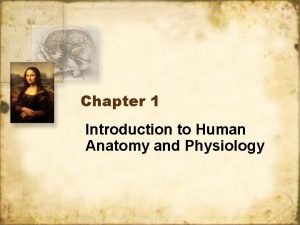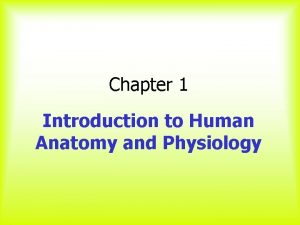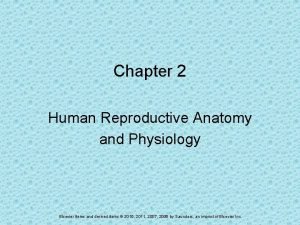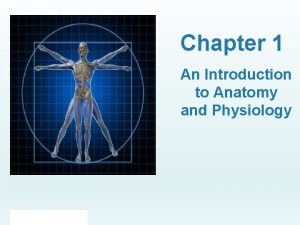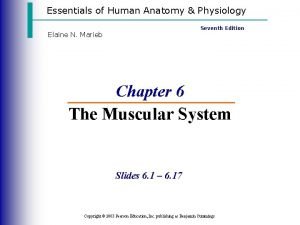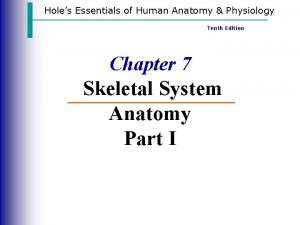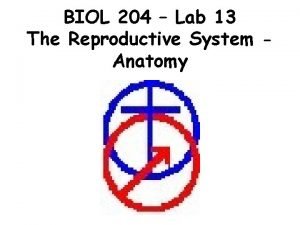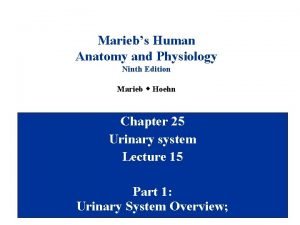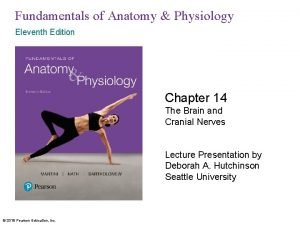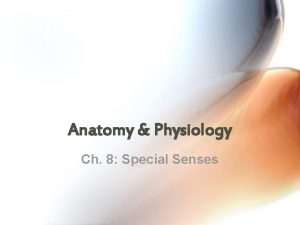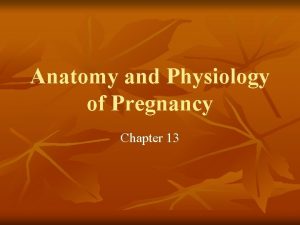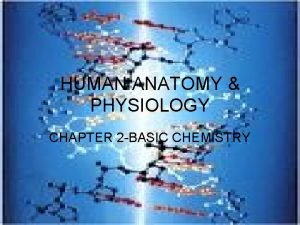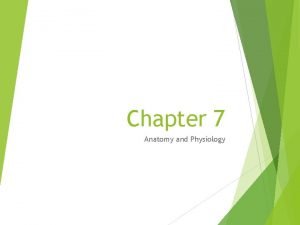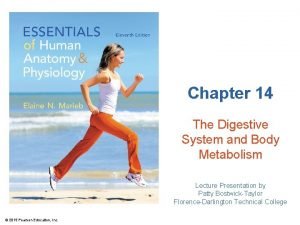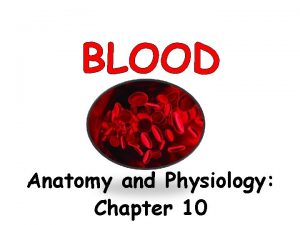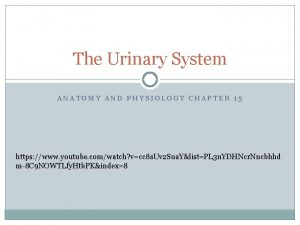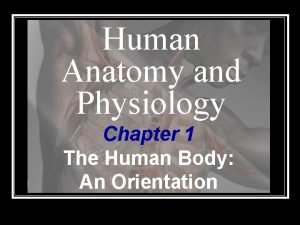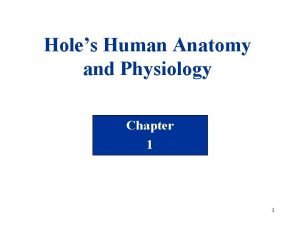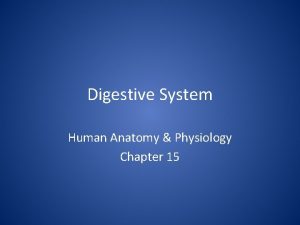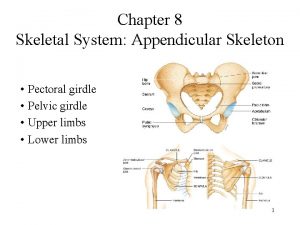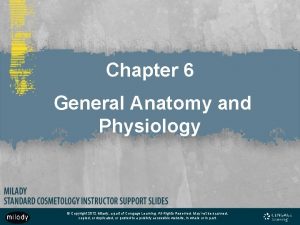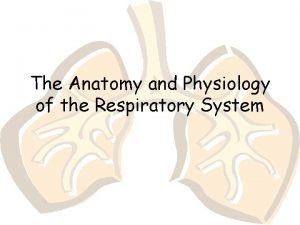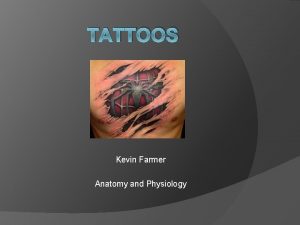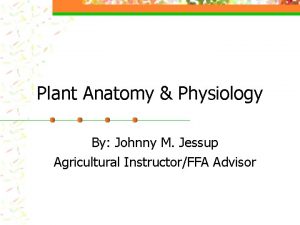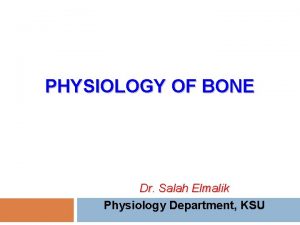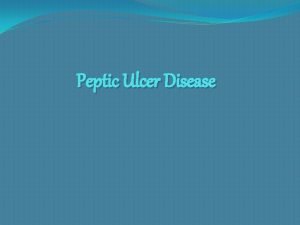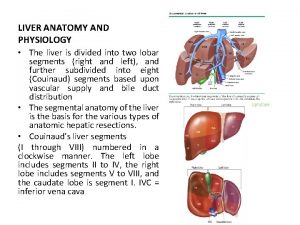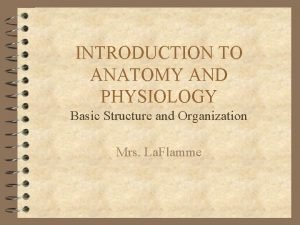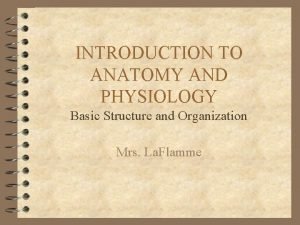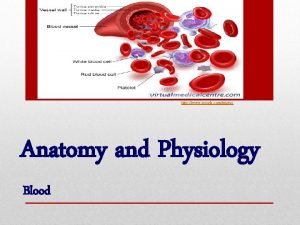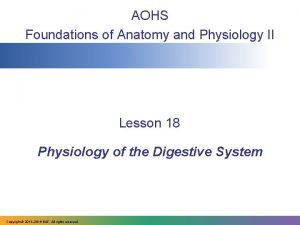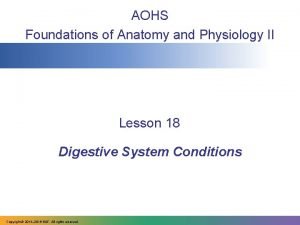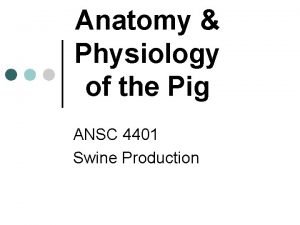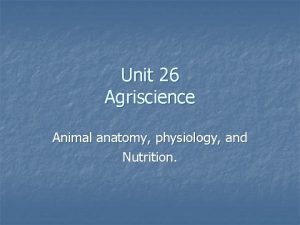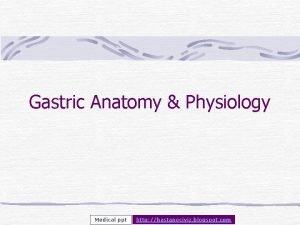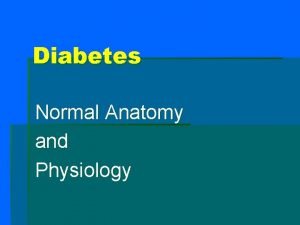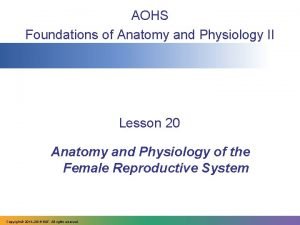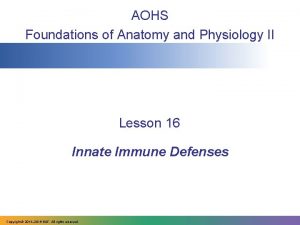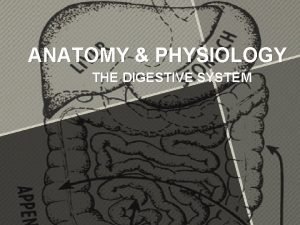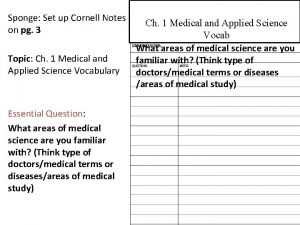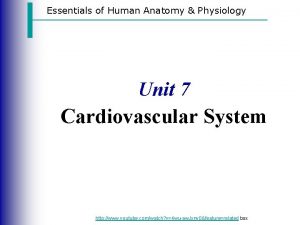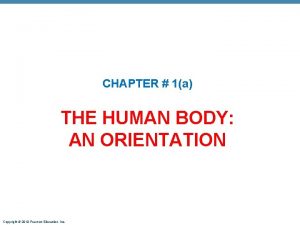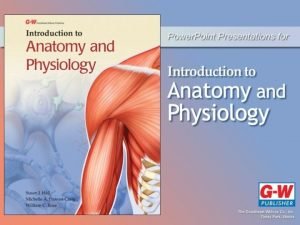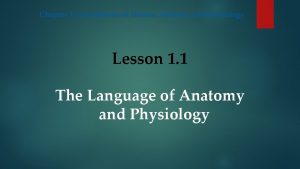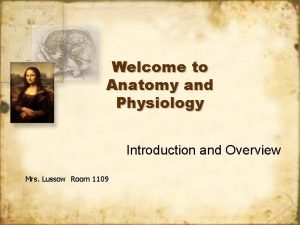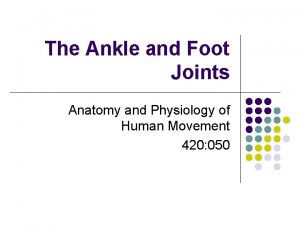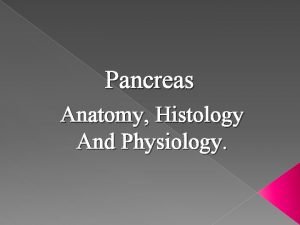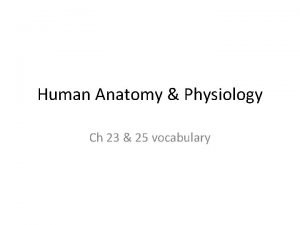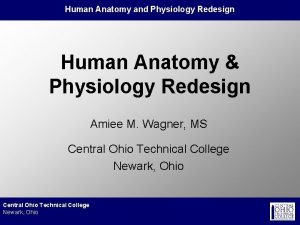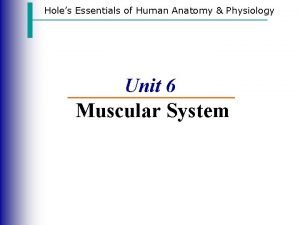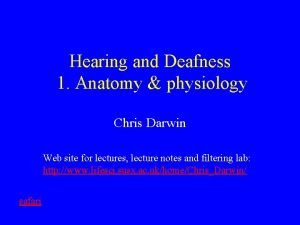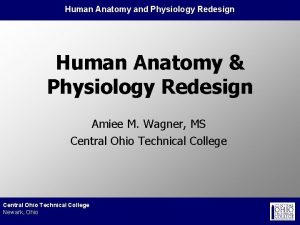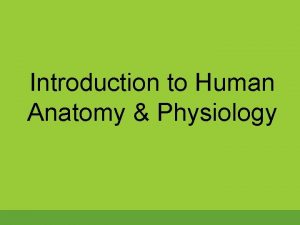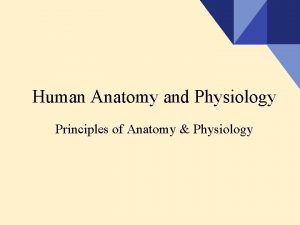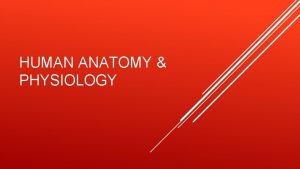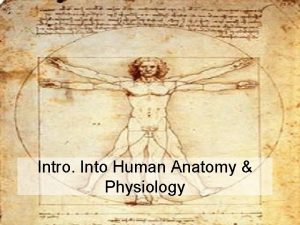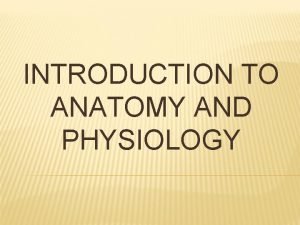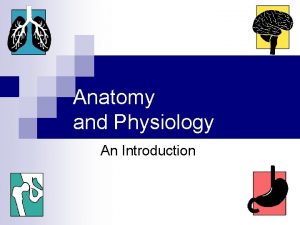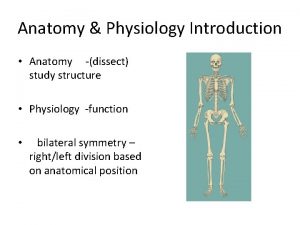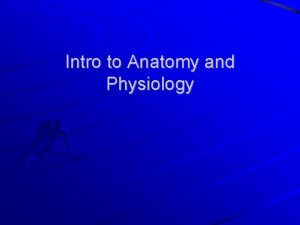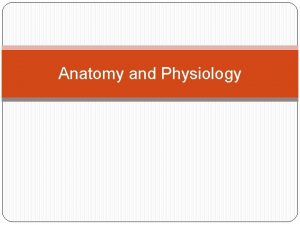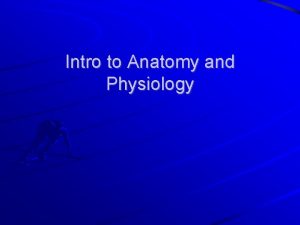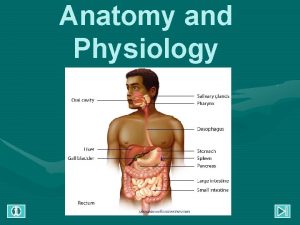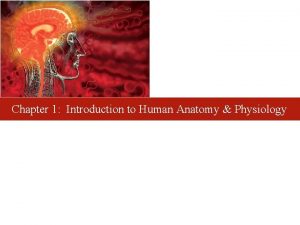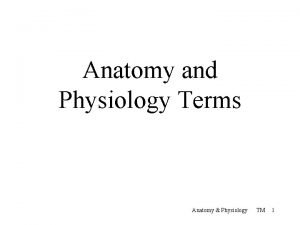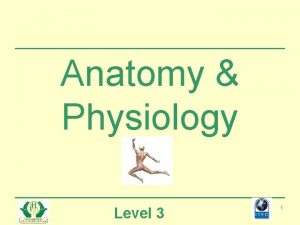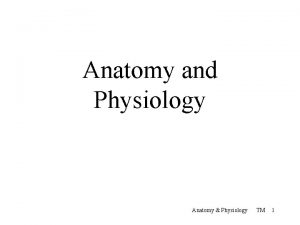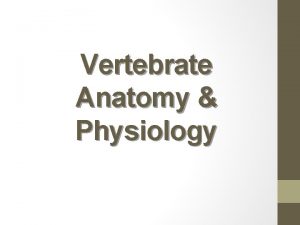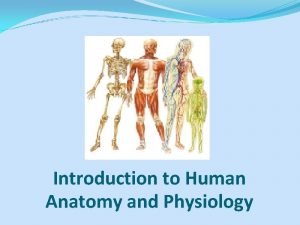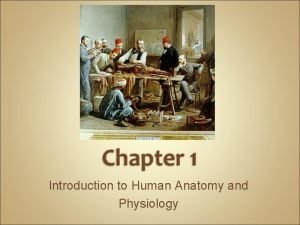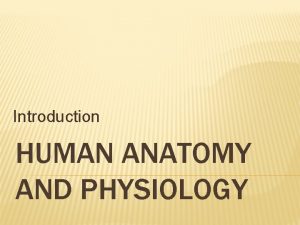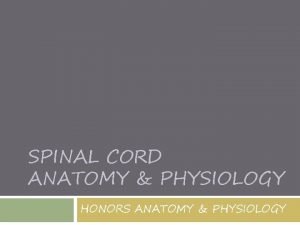Chapter 1 Introduction to Human Anatomy and Physiology
























































- Slides: 56

Chapter 1 Introduction to Human Anatomy and Physiology

Introduction Human Anatomy and Physiology: study of the structure and function of the human body 2

Importance of A & P • • Understand how body responds to a stimulus Understand basis of disease Essential knowledge for health care workers Improve your understanding of treatments, advertisements, and reports as a patient/client/consumer 3

I. Anatomy • Scientific discipline that investigates the structure of the body – Anatomy = to dissect parts of the body for study 4

A. Structure & Function • • The structure of a body part is closely related to its function Understanding this relationship makes learning anatomy easier 5

Types of Anatomical Study B. C. D. Systemic – by systems (e. g. nervous) Regional – body areas (e. g. head) Surface – external features (e. g. bony projections) E. Anatomical Imaging – pictures of internal structures (x-rays, ultrasound, magnetic resonance imaging) 6

II. Physiology • • The study of nature The scientific discipline that deals with the processes or functions of living things 7

A. Major goals of physiology 1. To understand predict the body’s responses to stimuli. 2. To understand how the body maintains conditions within a narrow range of values in the presence of a continually changing environment. 8

B. Human Physiology • The study of the processes and functions of humans 9

C. Cellular and Systemic Physiology • The studies of physiology that emphasize specific organizational levels 10

III. Structural and Functional Organization 11

A. Six Structural Levels 1. Chemical – interactions among atoms and their combinations into molecules a. H, O, N, C = 96% of human body 2. Cell – basic living units of organisms a. Contain organelles which each have specific functions 12

Structural Levels, continued… 3. Tissue – a group of similar cells and materials surrounding them that act together to perform a common function a. Epithelial, connective, muscle, nervous 13

Structural Levels, continued… 4. Organ – group of two or more tissue types working together to perform a special function a. Heart, lung, kidney, spleen 14

15 Organs

Structural Levels, continued… 5. Organ System – group of organs classified as a unit because of common function or set of functions 16

Organ Systems, continued… a. Integumentary System • • • Provides protection Regulates temperature Prevents water loss Produces vitamin D precursors Skin, hair, nails, sweat glands 17

Organ Systems, continued… b. Skeletal System • • • Provides protection & support Allows body movements Produces blood cells Stores minerals and fat Bones, cartilages, ligaments, joints 18

Organ Systems, continued… c. Muscular system • • Produces body movements Maintains posture Produces body heat Muscles (attached to skeleton by tendons) 19

Organ Systems, continued… d. Lymphatic system • • • Removes foreign substances from blood and lymph Combats disease Maintains tissue fluid balance Absorbs fats from digestive tract Lymphatic vessels, lymph nodes, and other lymphatic organs 20

Organ Systems, continued… e. Respiratory system • • • Exchanges oxygen and carbon dioxide between blood and air Regulates blood p. H Lungs and respiratory passages 21

Organ Systems, continued… f. Digestive system • • Performs the mechanical and chemical processes of digestion, absorption of nutrients, and elimination of wastes Mouth, esophagus, stomach, intestines, and accessory organs 22

Organ Systems, continued… g. Nervous system • • • Major regulatory system that detects sensations Controls movements, physiologic processes, and intellectual functions Brain, spinal cord, nerves, and sensory receptors 23

Organ Systems, continued… h. Endocrine system • • Major regulatory system that influences metabolism, growth, reproduction, and many other functions Glands (e. g. pituitary) that secrete hormones 24

Organ Systems, continued… i. Cardiovascular system • • • Transports nutrients, waste products, gases, and hormones throughout body Plays role in immune response and body temperature regulation Heart, blood vessels, and blood 25

Organ Systems, continued… j. Urinary system • • • Removes waste products from blood Regulates blood p. H, ion balance, and water balance Kidneys, urinary bladder, and ducts that carry urine 26

Organ Systems, continued… h. Reproductive System (Female) • • • Produces oocytes Site of fertilization and fetal development Produces milk Produces hormones that influence sexual function and behaviors Ovaries, vagina, uterus, mammary glands, and associated structures 27

Organ Systems, continued… h. Reproductive System (Male) • • • Produces and transfers sperm cells to female Produces hormones that influence sexual functions and behaviors Testes, accessory structures, ducts, and penis 28

Structural Levels, continued… 6. Organism – any living thing considered as a whole a. Unicellular, multicellular b. Human organism is a complex of organ systems that are mutually dependent on one another 29

IV. Characteristics of Life A. Six Essential Characteristics of Life 1. Organization – an organism’s parts are interrelated a. All living things are composed of cells 2. Metabolism (Energy) – ability to use energy to perform vital functions such as growth, movement, and reproduction a. Energy from sun (plants) or food (animals) 30

Six Essential Characteristics of Life, continued… 3. Homeostasis – ability of an organism to sense changes in the environment and make the adjustment that help maintain its life 4. Growth – ability of an organism to increase in size (partially or totally) a. Either by increasing cell number or cell size 31

Six Essential Characteristics of Life, continued… 5. Cells – all organisms are made of one more cells 6. Reproduction – the formation of new cells or organisms a. Sexual or asexual reproduction 32

B. Environmental Requirements of Organisms require certain factors in their environment or surroundings: 1. Water 2. Foods 3. Oxygen 4. Heat – energy from metabolic reactions 5. Pressure a. Atmospheric breathing b. Hydrostatic blood pressure 33

V. Homeostasis – Maintenance of Life • The existence and maintenance of a relatively constant environment within the body – Narrow range of conditions (variables) • Temperature, volume, chemical content – Set point = ideal normal value – Normal range = range of values in which an organism can operate normally 34

Examples: Cold = shiver Hot = sweat 35

D. Negative Feedback • Maintains homeostasis by resisting deviation from the set point 1. Three components: a. Receptor – monitors the value of a variable b. Control center – establishes the set point around which the variable is maintained c. Effector – can change the variable 36

Negative Feedback, continued… 2. Example: • • • Hole’s Essentials of Human Anatomy and Physiology, 8 th ed. , Shier, et al, 2003, Mc. Graw-Hill Higher Education Stimulus/Response: exercise increases HR and blood pressure increases Receptor: blood vessels near heart Control center: brain receives message and sends message to decrease HR Effector: heart decreases HR Response: blood pressure decreases 37

Negative Feedback, continued… 38

E. Positive Feedback • Mechanism by which any deviation from an ideal normal value or set point is made greater – Does not maintain homeostasis 39

Example Positive Feedback, continued… 40

VI. Terminology and the Body Plan • Etymology = the origin of a word – Example: Dorsal (dorsum, back) 41

A. Directional Terms 1. Anatomic Position – standing erect with the arms at the sides and palms turned forward 42

Directional Terms, continued… 43

Directional Terms, continued… 44

Directional Terms, continued… 45

B. Body Parts and Regions Anterior View 46

Body Parts and Regions, continued… Posterior View 47

Body Parts and Regions, continued… 48

C. Planes • Imaginary flat surfaces used to “look inside” and observe the body’s structures 49

Planes, continued… 50

D. Body Cavities 1. Thoracic cavity a. Boundaries: rib cage and diaphragm b. Contains: mediastinum, pericardial cavity (heart), left and right pleural cavities (lungs) c. Mediastinum contains esophagus, trachea, blood vessels, thymus, heart 51

D. Body Cavities 2. Abdominal Cavity a. b. 3. Pelvic Cavity a. b. 4. Boundaries: abdominal muscles Contains: stomach, intestines, liver, spleen, pancreas, and kidneys Bones of pelvis Contains: urinary bladder, part of large intestine, internal reproductive organs Abdominopelvic Cavity: abdominal and pelvic cavities 52

E. Serous Membranes 1. Visceral serous membranes cover organs (the “viscera”) 2. Parietal serous membranes form the outer wall of a fluid-filled cavity 3. A cavity is the fluid-filled space between the serous membranes 53

4. Thoracic Cavity and Membranes a. Pericardial Cavity surrounds the heart i. ii. Visceral pericardium covers heart Parietal pericardium lines pericardial cavity b. Pleural Cavity surrounds each lung i. ii. Visceral pleura cover lungs Parietal pleura line pleural cavity 54

5. Abdominopelvic Cavity and Membranes a. Peritoneal Cavity surrounds the many organs in the abdominopelvic cavity and the inferior surface of the diaphragm i. Visceral peritoneum covers organs ii. Parietal peritoneum lines peritoneal cavity • Pleural Cavity surrounds each lung i. ii. Visceral pleura cover lungs Parietal pleura line pleural cavity 55

Abdominopelvic Cavity and Membranes, continued… ii. Mesenteries – 2 layers of fused peritoneum that hold abdominal organs in place; provide passage for blood vessels and nerves iii. Retroperitoneal organs – organs “behind” parietal peritoneum • Kidneys, adrenal glands, pancreas, parts of intestines, and bladder 56
 Chapter 1 introduction to human anatomy and physiology
Chapter 1 introduction to human anatomy and physiology Medial and lateral
Medial and lateral Chapter 2 human reproductive anatomy and physiology
Chapter 2 human reproductive anatomy and physiology Chapter 1 an introduction to anatomy and physiology
Chapter 1 an introduction to anatomy and physiology Human anatomy and physiology seventh edition marieb
Human anatomy and physiology seventh edition marieb Holes essential of human anatomy and physiology
Holes essential of human anatomy and physiology Uterus perimetrium
Uterus perimetrium Anatomy and physiology ninth edition
Anatomy and physiology ninth edition The central sulcus divides which two lobes? (figure 14-13)
The central sulcus divides which two lobes? (figure 14-13) Anatomy and physiology chapter 8 special senses
Anatomy and physiology chapter 8 special senses Chapter 13 anatomy and physiology of pregnancy
Chapter 13 anatomy and physiology of pregnancy Anatomy and physiology chapter 2
Anatomy and physiology chapter 2 Chapter 7 anatomy and physiology
Chapter 7 anatomy and physiology Anatomy and physiology coloring workbook chapter 14
Anatomy and physiology coloring workbook chapter 14 Chapter 10 blood anatomy and physiology
Chapter 10 blood anatomy and physiology Anatomy and physiology chapter 15
Anatomy and physiology chapter 15 Anatomy and physiology chapter 1
Anatomy and physiology chapter 1 Holes anatomy and physiology chapter 1
Holes anatomy and physiology chapter 1 Gi tract histology
Gi tract histology Pectoral girdle acetabulum
Pectoral girdle acetabulum Chapter 6 general anatomy and physiology
Chapter 6 general anatomy and physiology Anatomy of upper respiratory tract
Anatomy of upper respiratory tract Tattoo anatomy and physiology
Tattoo anatomy and physiology Anatomy science olympiad
Anatomy science olympiad Perfect vs imperfect flower
Perfect vs imperfect flower Bone anatomy and physiology
Bone anatomy and physiology Tripple therapy
Tripple therapy Liver anatomy
Liver anatomy Hypogastric region
Hypogastric region Epigastric vs hypogastric
Epigastric vs hypogastric Rbc anatomy and physiology
Rbc anatomy and physiology Http://anatomy and physiology
Http://anatomy and physiology Appendectomy anatomy and physiology
Appendectomy anatomy and physiology Aohs foundations of anatomy and physiology 1
Aohs foundations of anatomy and physiology 1 Aohs foundations of anatomy and physiology 1
Aohs foundations of anatomy and physiology 1 Anatomical planes
Anatomical planes Unit 26 animal anatomy physiology and nutrition
Unit 26 animal anatomy physiology and nutrition Science olympiad forensics cheat sheet
Science olympiad forensics cheat sheet Physiology of stomach ppt
Physiology of stomach ppt Anatomy and physiology of diabetes
Anatomy and physiology of diabetes Aohs foundations of anatomy and physiology 1
Aohs foundations of anatomy and physiology 1 Aohs foundations of anatomy and physiology 1
Aohs foundations of anatomy and physiology 1 What produces bile
What produces bile Cornell notes for anatomy and physiology
Cornell notes for anatomy and physiology Anatomy and physiology unit 7 cardiovascular system
Anatomy and physiology unit 7 cardiovascular system Anatomy and physiology
Anatomy and physiology The speed at which the body consumes energy
The speed at which the body consumes energy Aohs foundations of anatomy and physiology 1
Aohs foundations of anatomy and physiology 1 Animal physiology exam 1
Animal physiology exam 1 Welcome to anatomy and physiology
Welcome to anatomy and physiology Physiology of the foot and ankle
Physiology of the foot and ankle Skin cancer
Skin cancer Pancreas anatomy and physiology
Pancreas anatomy and physiology Anatomy and physiology vocabulary
Anatomy and physiology vocabulary Anatomy and physiology
Anatomy and physiology Biceps muscle names
Biceps muscle names Anatomy and physiology
Anatomy and physiology
